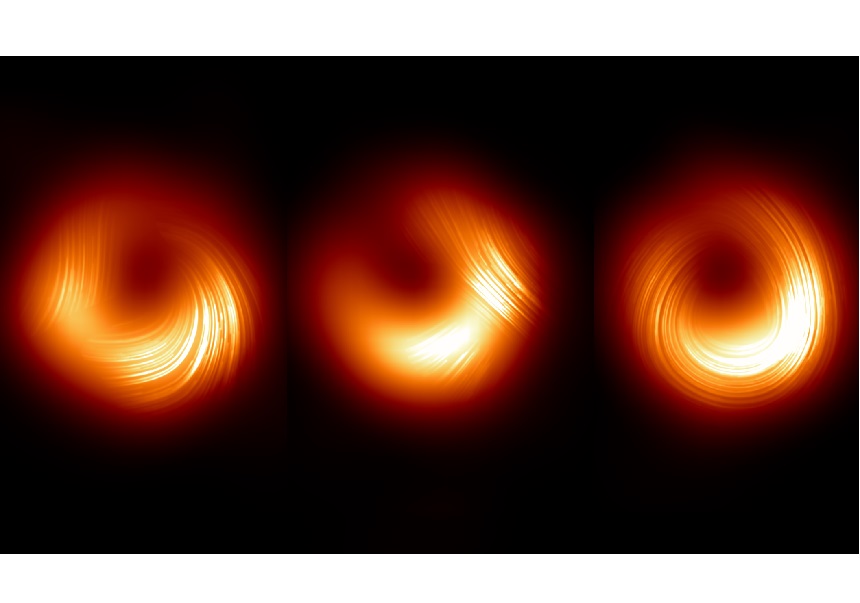
The Event Horizon Telescope (EHT) Collaboration, a global network of radio telescopes capable of turning the Earth into a single virtual telescope – of which the Radio Astronomy Group of the University of Valencia (UV) is a member – has just published a series of new images of the central black hole of the galaxy M87 (known as M87*). The images reveal changing polarised structures, related to a highly dynamic environment around the event horizon (the region of the black hole from which nothing can escape, not even light).
In addition, this research provides the first evidence of emission of the relativistic jet (an enormous, almost cylindrical structure formed by material being ejected at high speeds from the surroundings of the black hole) directly connected to the ring of light, offering insights into how the relativistic jet originates from the vicinity of the event horizon.
These new results, published today in the journal Astronomy & Astrophysics, shed new light on the problem of how matter and energy behave in the vicinity of such black holes.
“These results confirm what we had already learned about M87*, thanks to the EHT, but they also raise new and fascinating questions about physics near black holes”, comments Iván Martí-Vidal, a member of the EHT and researcher and lecturer in the Department of Astronomy and Astrophysics at the University of Valencia.
At a distance of about 55 million light-years, a supermassive black hole of more than 6 billion solar masses lies at the heart of the M87 galaxy. The EHT released the first image of the M87 black hole in April 2019, based on observations taken in 2017. Now, by combining those data with new observations taken in 2018 and 2021, EHT astronomers have taken the next step towards understanding how magnetic fields work and change near the event horizon.
“What is remarkable about these results is that, while the ring of light has maintained its size over the years (confirming Einstein’s general relativity), the polarisation patterns have changed significantly”, says Paul Tiede, astronomer at the CfA (Harvard/Smithsonian) and co-author of the article. “This tells us that the magnetised plasma surrounding the black hole is anything but stationary; it is dynamic and complex, which pushes the predictability of our theoretical models to the limit”.
“Year after year, we are improving the EHT network, adding new telescopes and upgrading the instrumentation and algorithms”, notes Michael Janssen, assistant professor at Radboud University (Nijmegen) and member of the EHT scientific committee. “All these improvements allow us to refine these new results, which will surely keep us busy for a long time”.
Between 2017 and 2021, the polarisation pattern (essentially, the shape of the polarised image) of M87* changed dramatically. In 2018, it appeared opposite to that of 2017 (that is, spiralling in the opposite direction), only to return to the original orientation in 2021. “These results, especially those from 2018, were completely unexpected”, comments Jongho Park of Kyunghee University and a member of the EHT.
“Such a radical change in the polarised structure could point to several causes, either within the emission region itself or linked to some changing magnetised plasma envelope”, says Ezequiel Albentosa, doctoral student at the University of Valencia and member of the EHT.
As the EHT continues to expand its observational capabilities, the new results being obtained remain a source of fascination for both astronomers (who are gaining deep insights into the dynamics of black holes) and the general public. “These results show how the EHT is evolving into an observatory capable not only of producing stunning images, but also of helping to build a coherent and robust understanding of black hole physics”, concludes Mariafelicia De Laurentis, professor at the University of Naples Federico II and scientist on the EHT project.
Reference article:
https://www.aanda.org/component/article?access=doi&doi=10.1051/0004-6361/202555855
Caption: Polarised images of M87* obtained with the EHT at a frequency of 230 GHz. The lines mark the orientation of the electric field of the light received by the telescopes (locally perpendicular to the magnetic fields, although spatial curvature effects must be taken into account). Left, centre and right: observations taken in 2017, 2018 and 2021, respectively. Credits: EHT Collaboration (2025)
Video: https://www.youtube.com/watch?v=YTNryi22VWE (Animation showing how the EHT images of M87 would look like if passed through a light polariser – like those used in reflex cameras or 3D cinema glasses). Credits: I. Martí-Vidal, EHT Collaboration.

.jpg)








